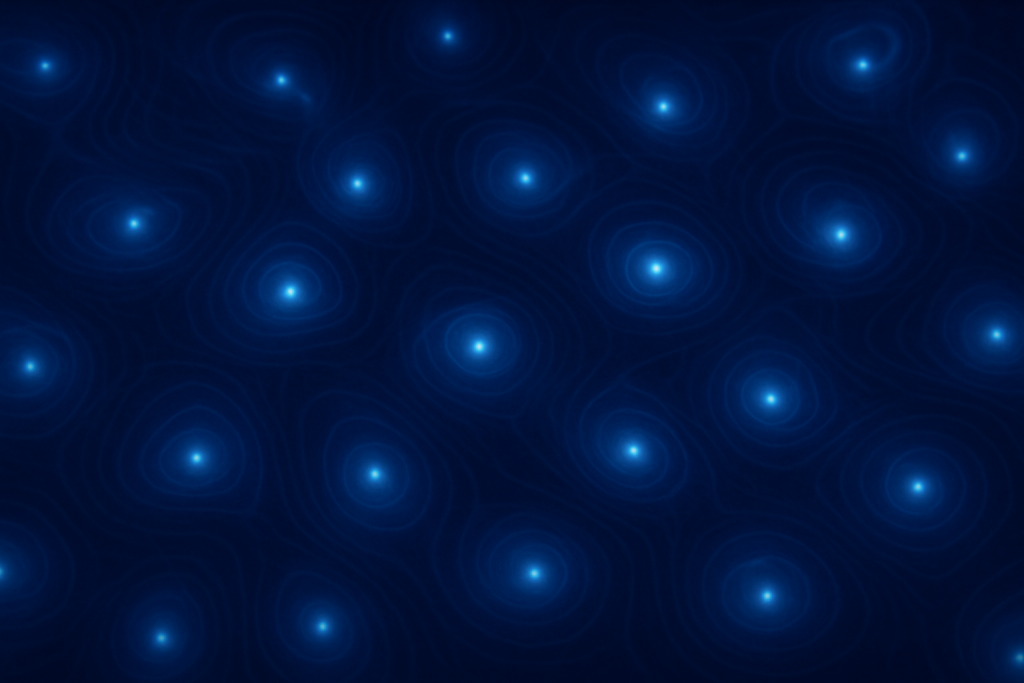The UNESCO 2025 International Year of Quantum Science and Technology celebrates a century of quantum mechanics [1] which is the foundation of countless technological applications—such as smartphones—that have reshaped our life. Even after 100 years, many quantum phenomena remain unexplored, and their understanding paves the way for the technologies of tomorrow.
Quantum mechanics defies human intuition because its effects are imperceptible in our everyday macroscopic world. To observe them, we may delve into the microscopic realm of ultracold atoms, cooled to temperatures close to absolute zero (-273 °C). Under these extreme conditions, each atom behaves like a wave of matter. As the temperature decreases, this quantum wave-like nature becomes more visible. Waves of single atoms interfere, by giving rise to a giant wave associated with the system of many atoms.
Ensembles of ultracold atoms provide then exceptional platforms for amplifying quantum effects up to macroscopic length scales. The average velocity of these atoms is nearly a million times smaller than that of air molecules. In addition, the typical density of these atomic clouds is about a billion times lower than that of the air, by preventing the transition to a solid state that would otherwise be induced by the low temperatures and the interactions between atoms.
The 1925 marked the theoretical prediction of a new quantum state of matter: the Bose–Einstein condensate, which exhibits exotic features—such as the macroscopic wave behavior—absent in any previously known state (gas, liquid, or solid). Only in 1995, physicists succeeded in creating the first ultracold atomic gas in which the condensate was finally observed. This landmark achievement opened an entirely new field of research and allowed the awarding of the Nobel Prize in Physics in 2001.
In 2015, a fascinating quantum liquid was envisioned in a mixture of ultracold atoms [2] and it displays properties radically different from those of water, being a billion times colder and 100 million times more dilute. In 2018, this ultracold liquid was finally realized in experimental laboratories [3]. A few years later, its thermal phase transition was theoretically investigated [4]. Remarkably, beyond the expected evaporation, this transition is also characterized by a distinct mechanism absent in water: once the critical temperature is reached, the liquid suddenly vanishes, by transforming completely into gas.
Quantum effects are macroscopic in atomic ensembles, making them easily observable in experiments and allowing for an unprecedented level of understanding. Ultracold atomic clouds can therefore serve as powerful simulators of the quantum behavior of other, less accessible many-particle systems—from electrons in metals to nuclear matter in neutron stars.
The understanding of quantum phenomena also plays a pivotal role in the development of technologies. Visionary applications include the world’s most precise atomic quantum clocks, a quantum internet enabling ultra-secure connections, and quantum computers capable of performing calculations in minutes that would take 100 centuries with today’s most powerful supercomputers.
100 years of quantum is, in truth, just the beginning—and we are excited about the discoveries to come, which will once again shape our future.
[2] D. S. Petrov, Phys. Rev. Lett. 115, 155302 (2015)
[3] C. R. Cabrera et Al., Science 359, 301 (2018)
G. Semeghini et Al., Phys. Rev. Lett. 120, 235301 (2018)
[4] G. De Rosi et Al., Phys. Rev. A 103, 043316 (2021)
Assistant Professor and Researcher in Theoretical Physics at UPC – Universitat Politècnica de Catalunya.
After earning a MSc from Sapienza (Rome) and a PhD in Trento, she moved to Barcelona to work at ICFO – The Institute of Photonic Sciences.
Her expertise spans a broad range of topics at the interface of condensed matter, atomic, nuclear, and quantum many-body physics. She has published novel theoretical predictions directly testable in current experiments and has presented her work at leading institutions worldwide.
Her research has been fully funded through highly competitive and prestigious individual grants, including two Marie Skłodowska-Curie (Europe), Juan de la Cierva-Incorporación (Spain), Angelo Della Riccia (Italy/Switzerland), and ARC Centre of Excellence FLEET (Australia) fellowships. She is also the recipient of several notable awards, including the Seal of Excellence from the European Commission.
Beyond academia, she is actively involved in outreach and Women in Science initiatives across several countries.
Further information is available on her website: giuliaderosi.wordpress.com


